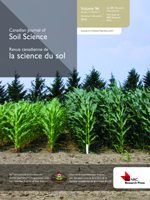Miller, J. J., Beasley, B. W., Drury, C. F., Hao, X. and Larney, F. J. 2014. Soil properties following long-term application of stockpiled feedlot manure containing straw or wood-chip bedding under barley silage production. Can. J. Soil Sci. 94: 389-402. The influence of long-term land application of stockpiled feedlot manure (SM) containing either wood-chip (SM-WD) or straw (SM-ST) bedding on soil properties during the barley (Hordeum vulgare L.) silage growing season is unknown. The main objective of our study was determine the effect of bedding material in stockpiled manure (i.e., SM-WD vs. SM-ST) on certain soil properties. A secondary objective was to determine if organic amendments affected certain soil properties compared with unamended soil. Stockpiled feedlot manure with SM-WD or SM-ST bedding at 77 Mg (dry wt) ha-1 yr-1 was annually applied for 13 to 14 yr to a clay loam soil in a replicated field experiment in southern Alberta. There was also an unamended control. Soil properties were measured every 2 wk during the 2011 and 2012 growing season. Properties included water-filled pore space (WFPS), total organic C and total N, NH4-N and NO3-N, water-soluble non-purgeable organic C (NPOC), water-soluble total N (WSTN), denitrification (acetylene inhibition method), and CO2 flux. The most consistent and significant (P≤0.05) bedding effects on soil properties in both years occurred for total organic C, C:N ratio, and WSTN. Total organic C and C:N ratio were generally greater for SM-WD than SM-ST, and the reverse trend occurred for WSTN. Bedding effects on other soil properties (WFPS, NH4-N, NO3-N, NPOC) occurred in 2012, but not in 2011. Total N, daily denitrification, and daily CO2 flux were generally unaffected by bedding material. Mean daily denitrification fluxes ranged from 0.9 to 1078 g N2O-N ha-1 d-1 for SM-ST, 0.8 to 326 g N2O-N ha-1 d-1 for SM-WD, and 0.6 to 250 g N2O-N ha-1 d-1 for the CON. Mean daily CO2 fluxes ranged from 5.3 to 43.4 kg CO2-C ha-1 d-1 for SM-WD, 5.5 to 26.0 kg CO2-C ha-1 d-1 for SM-ST, and from 0.5 to 6.8 kg CO2-C ha-1 d-1 for the CON. The findings from our study suggest that bedding material in feedlot manure may be a possible method to manage certain soil properties.
How to translate text using browser tools
5 February 2014
Soil properties following long-term application of stockpiled feedlot manure containing straw or wood-chip bedding under barley silage production
J. J. Miller,
B. W. Beasley,
C. F. Drury,
X. Hao,
F. J. Larney
ACCESS THE FULL ARTICLE
It is not available for individual sale.
This article is only available to subscribers.
It is not available for individual sale.
It is not available for individual sale.

Canadian Journal of Soil Science
Vol. 94 • No. 3
August 2014
Vol. 94 • No. 3
August 2014
azote
barley
bedding
carbon dioxide
copeaux de bois
denitrification
Dénitrification




